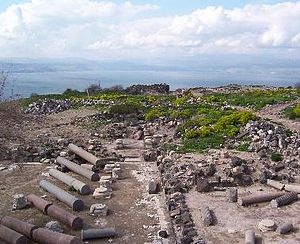Hippos
Hippos was a Greco-Roman city in the Decapolis , built on a flat hill at the foot of the Golan Heights , about 350 m above and 2 km east of the Sea of Galilee . A small port facility located directly on the lake belonged to the city.
The name of the city is said to derive from the shape of the hill on which it is located. Seen from above, it is vaguely reminiscent of the head and neck of a horse, which is why it received the Greek name Hippos ("horse"). The Aramaic name Susita also means "horse". The Arabic name Qal'at el-Husn means "fortress of the horse". Alternative spellings ( Hippus and Latinized Hippum ) are also documented.
Excavations
The first investigations were carried out in 1885 by the German archaeologist Gottlieb Schumacher , who, however, mistakenly identified the site as Gadara .
The first excavations were carried out between 1951 and 1955 by the Israeli archaeologist Claire Epstein . They found a Byzantine church, presumably the seat of the bishop of Hippos. After the excavations ended, the Israeli army, like the ancient Greeks, used the hill as a fortress until the occupation of the Golan Heights in the Six Day War .
Another excavation began in 2000, led by Arthur Segal of Haifa University . The twelve campaigns carried out up to 2011 focused on twelve excavation sites, including:
- the roman forum,
- a small Roman temple (imperial cult),
- a great Hellenistic temple,
- two Byzantine churches,
- the northeastern residential complexes,
- the Roman city gates and
- Parts of the northern and southern fortifications.
In September 2019, archaeologists uncovered Greek inscriptions and mosaics with Christian motifs, including an image of a basket with loaves of bread, a peacock and a fish in a burned Byzantine church. The church was probably set on fire during the Sassanid conquest in 614 AD. The excavations are supervised by Michael Eisenberg on behalf of the Institute for Archeology at the University of Haifa.
Web links
- Georg Beer : Hippos 4 . In: Paulys Realencyclopadie der classischen Antiquity Science (RE). Volume VIII, 2, Stuttgart 1913, Sp. 1913 f.
- Excavations of the University of Haifa
literature
- Arthur Segal, Michael Eisenberg, Jolanta Młynarczyk, Mariusz Burdajewicz, Mark Schuler: Hippos-Sussita of the Decapolis I: The First Twelve Seasons of Excavations 2000–2011. The Zinman Institute of Archeology, Haifa 2013, ISBN 978-965-7547-03-8 .
- Arthur Segal, Michael Eisenberg: The Spade Hits Sussita. In: Biblical Archeology Review 32/3 (2006), pp. 41-51, 78.
- Arthur Segal, Michael Eisenberg: Sussita-Hippos of the Decapolis: Town Planning and Architecture of a Roman-Byzantine City. In: Near Eastern Archeology 70/2 (2007), pp. 86-107.
- Arthur Segal: Hippos-Sussita - A city of the Decapolis on Lake Gennesaret in the Hellenistic and Roman periods . In: Jürgen Zangenberg , Jens Schröter (Ed.): Farmers, fishermen and prophets. Galilee in the time of Jesus . von Zabern, Darmstadt 2012, ISBN 978-3-8053-4543-9 , pp. 113–128.
Individual evidence
- ↑ Researchers find mosaic with Christian motifs. In: Israelnetz .de. September 6, 2019, accessed September 11, 2019 .
Coordinates: 32 ° 46 ′ 44 " N , 35 ° 39 ′ 34" E

